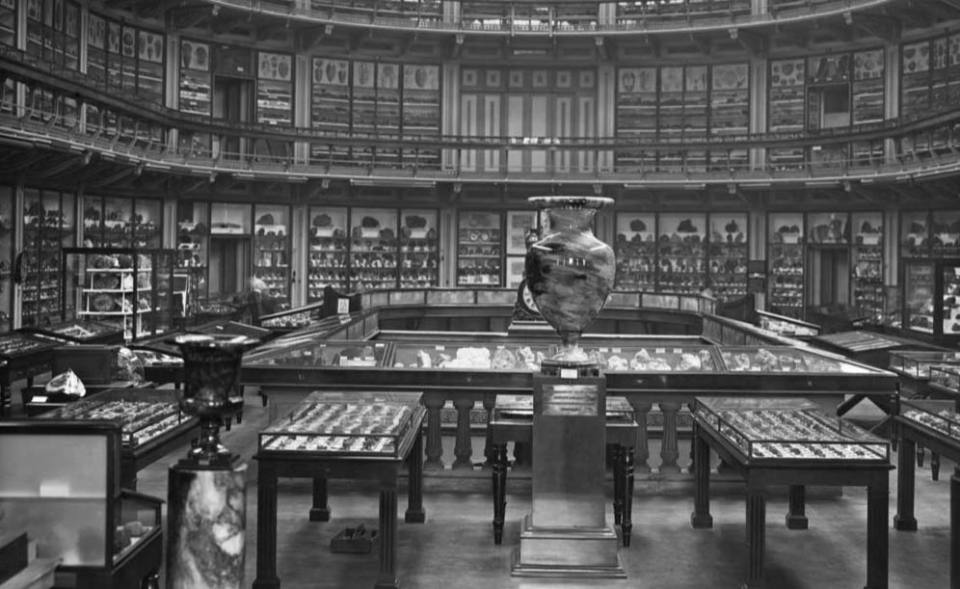The British Geological Survey is the world’s oldest national geological survey, founded in 1835. The survey has changed its name several times through its history, which is explained in brief below or, for further information, see the BGS archives and a comprehensive historical record on BGS Earthwise.
Quick links
1835 to1850
1835: the Ordnance Geological Survey
Thomas F Colby, Superintendent of the Ordnance Survey, recognised the practical value of a geological examination of the country and supported Henry Thomas de la Beche, vice president of the Geological Society, to undertake a geological survey of Devon. The success of this work led to establishment of the Ordnance Geological Survey in 1835 under the Board of Ordnance; de la Beche became its first director.

1835: the Museum of Economic Geology
In August 1835, de la Beche obtained funding from the Board of Works to establish a museum at Craig’s Court, Whitehall, London; the Museum of Economic Geology was opened in 1841. One of its most important acquisitions was some building stones proposed for the new Houses of Parliament.
1839: the Mining Record Office
By 1839, the survey included a new Mining Record Office that collected and stored abandoned mine plans, which was set up in response to a mining disaster. From about 1847, the survey also started collecting and publishing mineral production statistics and then international trade statistics, an activity that still happens today.
1845: the Geological Survey Act
The Geological Survey Act of 1845 provided the survey with a legal framework designed ‘to facilitate the completion of a geological survey of Great Britain and Ireland.’ Responsibility for the survey, which now incorporated the geological department in Ireland, passed from the Board of Ordnance to the Office of Woods, Forests, Land Revenues, Works and Buildings. This transition meant that field officers of the survey were no longer required to wear the military-style uniform of blue serge with brass buttons and a top hat!

1851 to1904
1851: a new Museum of Practical Geology
Having outgrown the limited accommodation at Craig’s Court, arrangements were put in hand in 1845 for erecting a new museum and offices for the survey. On 12 May 1851, the year of the Great Exhibition, the new Geological Survey and Museum of Practical Geology was formally opened by HRH Prince Albert in Jermyn Street, a prime London location. The survey offices and library were situated in the rear of the building, which fronted onto Piccadilly. Also included were a lecture theatre, laboratories and the Mining Record Office.

1851: the School of Mines
In November 1851, the Government School of Mines and of Science Applied to the Arts was inaugurated; this would go on to become the Royal School of Mines. The school, based in the museum at Jermyn Street, provided instruction in chemistry, natural history with palaeontology, mechanical science, metallurgy, geology and mining and mineralogy.
1872: separation of the Geological Survey and Museum from the Royal School of Mines
The Royal School of Mines and its teaching facilities were relocated from Jermyn Street to South Kensington, although the transfer was not fully completed until some years later. The school thus ceased to be part of the Geological Survey and Museum.

1905 to the present day
1905: the Geological Survey of Great Britain
On 1 April 1905, the Geological Survey of Ireland was transferred to the Department of Agriculture and Technical Instruction for Ireland. The Geological Survey of the United Kingdom (Great Britain & Ireland) was renamed the Geological Survey of Great Britain.
1919: the Department of Scientific and Industrial Research
On 1 November 1919, the Geological Survey and Museum was transferred to the Department of Scientific and Industrial Research (DSIR). Subsequently, the Department of Scientific and Industrial Research Act of 1956 amended aspects of the management of research functions and placed the DSIR under the charge of the Council for Scientific and Industrial Research, the forerunner of the current research councils.

1965: the Science and Technology Act and the creation of the Institute of Geological Sciences
The Natural Environment Research Council (NERC) — BGS’s parent body — was confirmed by Royal Charter as a result of the 1965 Science and Technology Act. The Geological Survey and Museum were combined with the Overseas Geological Surveys (OGS) in the following year and renamed the Institute of Geological Sciences (IGS).
1984: the British Geological Survey
On 1 January 1984, the Institute of Geological Sciences was renamed the British Geological Survey. The next year our headquarters were established at Keyworth, near Nottingham, and our offices at the Geological Museum at South Kensington were relinquished to the Natural History Museum and now form the Earth Galleries.

2018: British Geological Survey (and NERC) becomes part of UK Research and Innovation (UKRI)
UKRI brought together seven existing UK research councils, Innovate UK and the Research and Knowledge Exchange functions of the Higher Education Funding Council for England (HEFCE) into one unified body.




